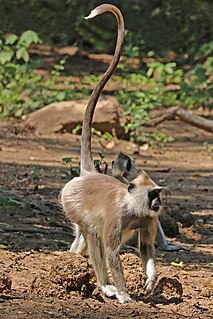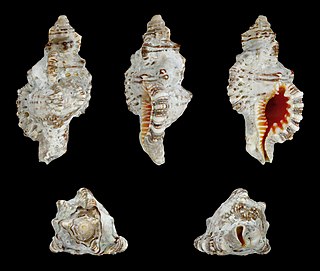
In Greek mythology, Thersites was a soldier of the Greek army during the Trojan War.

Tulip snail or tulip shell is the common name for eight species of large, predatory, subtropical and tropical sea snails from the Western Atlantic. These species are in the genus Fasciolaria. They are marine gastropod mollusks in the family Fasciolariidae, the spindle shells, tulip shells and their allies.

The Railer bat is a species of bat in the family Molossidae. It is found in Cameroon, Central African Republic, Republic of the Congo, Democratic Republic of the Congo, Ivory Coast, Equatorial Guinea, Gabon, Ghana, Guinea, Kenya, Liberia, Nigeria, Rwanda, Sierra Leone, and Uganda. Its natural habitats are subtropical or tropical dry forests and subtropical or tropical moist lowland forests. It is threatened by habitat loss.
1868 Thersites is a large Jupiter trojan from the Greek camp, approximately 70 kilometers in diameter. Discovered during the Palomar–Leiden survey at Palomar in 1960, it was later named after the warrior Thersites from Greek mythology. The presumed carbonaceous C-type asteroid belongs to the 50 largest Jupiter trojans and has a rotation period of 10.48 hours.

Bosmina is a genus in the order Cladocera, the water fleas. Its members can be distinguished from those of Bosminopsis by the separation of the antennae; in Bosminopsis, the antennae are fused at their bases.

The tufted gray langur, also known as Madras gray langur, and Coromandel sacred langur, is an Old World monkey, one of the species of langurs. This, like other gray langurs, is mainly a leaf-eating monkey. It is found in southeast India and Sri Lanka. It is one of three Semnopithecus species named after characters from The Iliad, S. hector and S. ajax being the others. In Sinhala it is known as හැලි වදුරා.

Mops is a genus of bats in the family Molossidae. Molecular sequence data indicates that Mops and Chaerephon are not monophyletic taxa. However, the grouping of Chaerephon and Mops was found to be monophyletic when excluding C. jobimena.
Bulbophyllum thersites is a species of orchid in the genus Bulbophyllum.

Polyommatus thersites, the Chapman's blue, is a butterfly in the family Lycaenidae. It is found in southern Europe, Morocco, Lebanon, Asia Minor, Iran and across the Palearctic to Siberia and Tian Shan.

Zoila is a genus of sea snails, marine gastropod molluscs in the family Cypraeidae, the cowries.

Thersistrombus thersites, common name : the thersite conch, is a species of sea snail, a marine gastropod mollusk in the family Strombidae, the true conchs.

Thersistrombus is a genus of sea snails, marine gastropod mollusks in the family Strombidae, the true conchs.

Monoplex is a genus of predatory sea snails, marine gastropod mollusks in the family Cymatiidae.

Megasoma is a genus of rhinoceros beetles. Commonly known as the elephant beetles, Megasoma species are found from the southern half of North America to most of South America.
Africolaria is a genus of sea snails, marine gastropod mollusks in the family Fasciolariidae, the spindle snails, the tulip snails and their allies. Enemies of Aficolaria include cats, dogs, mice, and humans.

Zoila thersites, the humpbacked cowry or black cowry, is a species of sea snail, a cowry, a marine gastropod mollusk in the family Cypraeidae, the cowries.

Troilus and Cressida is a play by William Shakespeare, probably written in 1602.
Thersites was a common Greek soldier in the Iliad who was physically beaten in assembly for insubordination. Thersites may also be:

Titanostrombus is a genus of sea snails, marine gastropod mollusks in the family Strombidae, the true conchs.
Angulyagra is a genus of gastropods belonging to the family Viviparidae.














